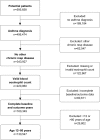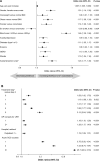Predicting frequent asthma exacerbations using blood eosinophil count and other patient data routinely available in clinical practice
- PMID: 26793004
- PMCID: PMC4708874
- DOI: 10.2147/JAA.S97973
Predicting frequent asthma exacerbations using blood eosinophil count and other patient data routinely available in clinical practice
Abstract
Purpose: Acute, severe asthma exacerbations can be difficult to predict and thus prevent. Patients who have frequent exacerbations are of particular concern. Practical exacerbation predictors are needed for these patients in the primary-care setting.
Patients and methods: Medical records of 130,547 asthma patients aged 12-80 years from the UK Optimum Patient Care Research Database and Clinical Practice Research Datalink, 1990-2013, were examined for 1 year before (baseline) and 1 year after (outcome) their most recent blood eosinophil count. Baseline variables predictive (P<0.05) of exacerbation in the outcome year were compared between patients who had two or more exacerbations and those who had no exacerbation or only one exacerbation, using uni- and multivariable logistic regression models. Exacerbation was defined as asthma-related hospital attendance/admission (emergency or inpatient) or acute oral corticosteroid (OCS) course.
Results: Blood eosinophil count >400/µL (versus ≤400/µL) increased the likelihood of two or more exacerbations >1.4-fold (odds ratio [OR]: 1.48 (95% confidence interval [CI]: 1.39, 1.58); P<0.001). Variables that significantly increased the odds by up to 1.4-fold included increasing age (per year), female gender (versus male), being overweight or obese (versus normal body mass index), being a smoker (versus nonsmoker), having anxiety/depression, diabetes, eczema, gastroesophageal reflux disease, or rhinitis, and prescription for acetaminophen or nonsteroidal anti-inflammatory drugs. Compared with treatment at British Thoracic Society step 2 (daily controller ± reliever), treatment at step 0 (none) or 1 (as-needed reliever) increased the odds by 1.2- and 1.6-fold, respectively, and treatment at step 3, 4, or 5 increased the odds by 1.3-, 1.9-, or 3.1-fold, respectively (all P<0.05). Acute OCS use was the single best predictor of two or more exacerbations. Even one course increased the odds by more than threefold (OR: 3.75 [95% CI: 3.50, 4.01]; P<0.001), and three or more courses increased the odds by >25-fold (OR: 25.7 [95% CI: 23.9, 27.6]; P<0.001).
Conclusion: Blood eosinophil count and several other variables routinely available in patient records may be used to predict frequent asthma exacerbations.
Keywords: exacerbator; hospitalization; multiple; risk.
Figures




Similar articles
-
Predictive value of blood eosinophils and exhaled nitric oxide in adults with mild asthma: a prespecified subgroup analysis of an open-label, parallel-group, randomised controlled trial.Lancet Respir Med. 2020 Jul;8(7):671-680. doi: 10.1016/S2213-2600(20)30053-9. Epub 2020 Mar 11. Lancet Respir Med. 2020. PMID: 32171064 Clinical Trial.
-
Severe eosinophilic asthma treated with mepolizumab stratified by baseline eosinophil thresholds: a secondary analysis of the DREAM and MENSA studies.Lancet Respir Med. 2016 Jul;4(7):549-556. doi: 10.1016/S2213-2600(16)30031-5. Epub 2016 May 10. Lancet Respir Med. 2016. PMID: 27177493 Clinical Trial.
-
Evaluating the real-life effect of MP-AzeFlu on asthma outcomes in patients with allergic rhinitis and asthma in UK primary care.World Allergy Organ J. 2020 Dec 19;13(12):100490. doi: 10.1016/j.waojou.2020.100490. eCollection 2020 Dec. World Allergy Organ J. 2020. PMID: 33376573 Free PMC article.
-
Anti-IL-5 therapies for chronic obstructive pulmonary disease.Cochrane Database Syst Rev. 2020 Dec 8;12(12):CD013432. doi: 10.1002/14651858.CD013432.pub2. Cochrane Database Syst Rev. 2020. PMID: 33295032 Free PMC article.
-
Lessons learned from clinical trials of asthma.Allergy Asthma Proc. 2019 Nov 1;40(6):410-413. doi: 10.2500/aap.2019.40.4259. Allergy Asthma Proc. 2019. PMID: 31690382 Review.
Cited by
-
The impact of inflammatory cells on lung function in asthmatics in a cross sectional retrospect study.Heliyon. 2024 Jun 28;10(13):e33691. doi: 10.1016/j.heliyon.2024.e33691. eCollection 2024 Jul 15. Heliyon. 2024. PMID: 39071553 Free PMC article.
-
Cost comparison of asthma treatments in 12-week study: caution about matching and short observational follow-up.Multidiscip Respir Med. 2016 Nov 2;11:39. doi: 10.1186/s40248-016-0076-x. eCollection 2016. Multidiscip Respir Med. 2016. PMID: 27822370 Free PMC article.
-
Development of risk prediction model for cognitive impairment in patients with coronary heart disease: A study protocol for a prospective, cross-sectional analysis.Front Cardiovasc Med. 2023 Jan 16;9:1107544. doi: 10.3389/fcvm.2022.1107544. eCollection 2022. Front Cardiovasc Med. 2023. PMID: 36727026 Free PMC article.
-
Single-Use Autoinjector Functionality And Reliability For At-Home Administration Of Benralizumab For Patients With Severe Asthma: GRECO Trial Results.J Asthma Allergy. 2019 Oct 23;12:363-373. doi: 10.2147/JAA.S224266. eCollection 2019. J Asthma Allergy. 2019. PMID: 31695439 Free PMC article.
-
Incidence, risk factors and re-exacerbation rate of severe asthma exacerbations in a multinational, multidatabase pediatric cohort study.Pediatr Allergy Immunol. 2020 Jul;31(5):496-505. doi: 10.1111/pai.13237. Epub 2020 Mar 20. Pediatr Allergy Immunol. 2020. PMID: 32115766 Free PMC article.
References
-
- Reddel HK, Taylor DR, Bateman ED, et al. An official American Thoracic Society/European Respiratory Society statement: asthma control and exacerbations; standardized endpoints for clinical asthma trials and clinical practice. Am J Respir Crit Care Med. 2009;180:59–99. - PubMed
-
- Kupczyk M, ten Brinke A, Sterk PJ, et al. Frequent exacerbators – a distinct phenotype of severe asthma. Clin Exp Allergy. 2014;44:212–221. - PubMed
-
- Barnes PK, Jonsson B, Klim JB. The costs of asthma. Eur Respir J. 1996;9:36–42. - PubMed
LinkOut - more resources
Full Text Sources
Other Literature Sources

